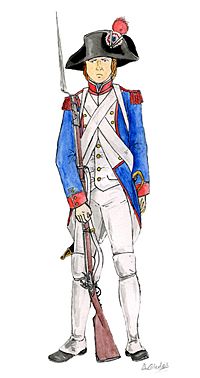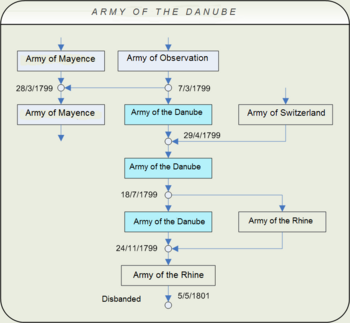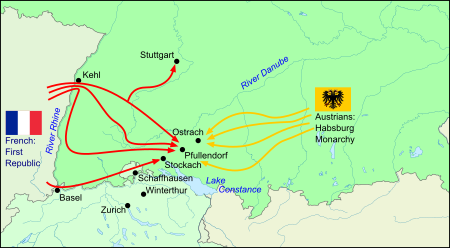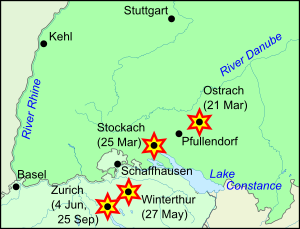Army of the Danube facts for kids
| Army of the Danube | |
|---|---|
Quick facts for kids 
Fusilier of a French Revolutionary Army
|
|
| Active | 2 March – 11 December 1799 |
| Country | |
| Engagements | Battle of Ostrach Battle of Stockach (1799) Battle of Winterthur (1799) First Battle of Zurich Second Battle of Zurich |
| Disbanded | 24 November 1799 and units merged into Army of the Rhine |
| Commanders | |
| Notable commanders |
Jean-Baptiste Jourdan André Masséna Louis Marie Turreau |
The Army of the Danube (French: Armée du Danube) was a French army during the French Revolutionary Wars. It was active in 1799 in the Upper Danube river valley. The army was formed on March 2, 1799, by simply changing the name of the "Army of Observation." This older army had been watching Austrian movements near the border between France and the Holy Roman Empire. General Jean-Baptiste Jourdan was its first commander.
The French government, called the Directory, wanted to reduce the power of the Habsburg family in the Holy Roman Empire. They also wanted to increase French influence in central Europe. Even after a peace treaty in 1797, France and Austria did not trust each other. The Army of Observation was created to keep an eye on Austrian border activities. When peace talks failed, the Army of Observation was ordered to cross the Rhine river.
Once renamed the Army of the Danube, its job was to take control of important areas in southwestern Germany. It was also meant to fight the Habsburg army led by Archduke Charles. At the same time, the Army of Helvetia, led by André Masséna, was to secure key locations in Switzerland. These included the St. Gotthard Pass and the Swiss Plateau.
The Army of the Danube fought in four main battles. In the Battle of Ostrach and the first Stockach battle, the French army lost many soldiers and had to retreat. After some changes, parts of the army joined Masséna's Army of Switzerland. They retreated again after fighting Charles's larger army near Zürich in June 1799. However, in the Second Battle of Zurich, the Army of the Danube won a clear victory. In December 1799, the Army of the Danube joined with the Army of the Rhine.
Contents
Why the War Started
At first, European rulers like Joseph II, Holy Roman Emperor thought the French Revolution was just a problem between the French king and his people. But as the revolution became more extreme, monarchs grew worried. Leopold, who became Emperor in 1791, was especially concerned about his sister, Marie Antoinette, the Queen of France.
Even though Leopold wanted to avoid war, he and the King of Prussia issued the Declaration of Pillnitz. They said that the safety of the French royal family was important to all European monarchs. They threatened serious consequences if anything happened to the king and his family.
By 1792, the situation in France was very difficult. French nobles who had left the country, called émigrés, tried to get other countries to help restore the king's power. They even raised a small army. A new, young emperor, Francis, took power in July 1792. He was less willing to compromise.
On April 20, 1792, France declared war on Austria. This started the War of the First Coalition (1792–98). France fought against most European countries that shared borders with it. Even though the Coalition forces won some battles, Napoleon Bonaparte's victories in Italy forced Austria to sign a peace treaty in 1797. This was the Treaty of Campo Formio.
After the treaty, France and Austria remained suspicious of each other. Several diplomatic problems arose. France wanted more land, and Austria was slow to give up territories. A meeting called the Congress at Rastatt failed to sort out these issues. Other events, like Napoleon taking Malta and French armies supporting new republics in Italy and Switzerland, also increased tensions.
What the Army Was For
French military leaders knew that the northern Rhine Valley, southwestern Germany, and Switzerland were very important for defending France. Controlling the Swiss mountain passes meant armies could move quickly between northern Italy and Germany. The Rhine river was a strong natural barrier against Austrian attacks. Controlling its crossing points was key. Also, controlling the Upper Danube river would allow France to move troops easily across Europe.
In late 1798, General Jourdan took command of the Army of Observation near Basel, Switzerland. Its job was to "observe" the French border on the Rhine. Jourdan found the army was not ready for its mission. It lacked soldiers, supplies, ammunition, and training. He wrote many letters to the Directory about these problems, but not much help arrived.
Jourdan's orders were to lead the army into Germany and capture important places. These included roads near Stockach and Schaffhausen, close to Lake Constance. Similarly, General André Masséna, leading the Army of Helvetia, was to secure strategic points in Switzerland. These included the St. Gotthard Pass and areas around Zürich and Winterthur. These positions would stop the enemy from moving troops between Italy and Germany. They would also ensure France could use these important passes. The goal was to control all western roads leading to Vienna, the capital of Austria.
Crossing the Rhine River
On March 1, 1799, the Army of Observation, with about 30,000 men, crossed the Rhine river. They crossed at Kehl and Basel. As units crossed, they officially became the Army of the Danube.
The army moved in four main groups:
- The Advance Guard: About 9,000 men, led by General François Joseph Lefebvre.
- First Division: About 8,000 men, led by General Pierre Marie Barthélemy Ferino.
- Second Division: About 7,000 men, led by General Joseph Souham.
- Third Division: About 7,000 men, led by Laurent Saint-Cyr.
- Reserve: About 3,000 men, with most of the artillery and horses, led by Jean-Joseph Ange d'Hautpoul.
The army advanced eastward. The First Division moved along the Rhine's north shore towards Lake Constance. The Advance Guard went northeast through the mountains. The other divisions followed, some through the Black Forest. Jourdan decided to position his army near Pfullendorf, planning to fight Archduke Charles's army there.
This location had problems. The area around Pfullendorf was marshy, especially in spring. This made it hard to use cavalry and reduced the effect of cannon fire. Fog was also common, making it difficult to see and plan. Jourdan knew that Charles's main army was not far away, but he still chose this difficult ground.
Key Battles of the Army of the Danube
In March 1799, the Army of the Danube fought two major battles in southwestern Germany. These were the Battle of Ostrach and the Battle of Stockach. The French suffered heavy losses in both and had to retreat. After these defeats, General Jourdan left the command. The army was reorganized, and parts of it joined Masséna's Army of Helvetia. The army then fought in the Battle of Winterthur and the First Battle of Zürich. Three months later, they fought and won the Second Battle of Zürich.
Battle of Ostrach
| Battle of Ostrach | |||||||
|---|---|---|---|---|---|---|---|
|
|||||||
| Belligerents | |||||||
| Commanders and leaders | |||||||
| Jean-Baptiste Jourdan | Archduke Charles | ||||||
| Strength | |||||||
| 18,000 | 52,000 | ||||||
| Casualties and losses | |||||||
| 2,257 (12.5%) | 2,113 (4%) | ||||||
The Battle of Ostrach took place from March 20–23, 1799. The French army pushed towards Pfullendorf and Ostrach. Their goal was to cut off the Austrian supply lines in Switzerland. This would stop the enemy from moving troops between central and southern Europe. It would also allow the French to control important routes.
The battle happened during Holy Week in 1799, in the rain and thick fog. On March 20, the French managed to capture Ostrach village. But on March 21, the Habsburg army attacked. General Jourdan later wrote that his men seemed to disappear in a "cloud of redcoats," referring to the Austrian uniforms. After more than 15 hours of fighting, the Austrians attacked the French left side. Saint Cyr's force was pushed back. As the fog lifted, Jourdan saw the large Austrian army below him. He realized he could not hold his position and had to retreat.
Both sides had many casualties. The Austrians had a much larger army of nearly 55,000 men at Ostrach. French casualties were over 12 percent of their force, while Austrian losses were about four percent. The French were forced to retreat to Stockach. There, on March 25, the armies fought again. This time, both sides lost more men, and the Austrians won a decisive victory.
Battle of Stockach
| Battle of Stockach (1799) | |||||||
|---|---|---|---|---|---|---|---|
|
|||||||
| Belligerents | |||||||
| Commanders and leaders | |||||||
| Jean-Baptiste Jourdan | Archduke Charles | ||||||
| Strength | |||||||
| 40,000 soldiers | 80,000 soldiers | ||||||
| Casualties and losses | |||||||
| 400 killed, 1600 wounded, 2,000 captured, 1 gun lost. | 500 killed, 2400 wounded, 2,900 captured, 2 guns lost. | ||||||
At the Battle of Stockach, General Jourdan led 40,000 French soldiers against Archduke Charles's 80,000 Habsburg troops. Jourdan was almost captured when his horse was shot, and he was nearly trampled by his own soldiers. Archduke Charles personally joined the fighting, which helped the Austrians win. The French were defeated and pushed back towards the Rhine.
The battle was very fierce. Before dawn on March 25, the French attacked the Austrian right side. This forced the Austrians out of the woods. Archduke Charles sent more troops to help. He even led eight battalions of Hungarian grenadiers himself. During this fight, two important Austrian leaders were killed. The main French attack on the center was stopped by the Austrians' greater numbers.
On the French right side, General Ferino tried to push the Austrians back. He used cannons and then attacked through the woods. The French managed to take a road but could not hold it. Jourdan then ordered a full retreat from the area. He set up his command post at Hornberg. He sent the cavalry to the western side of the Black Forest to find food for their horses.
Battle of Winterthur
By mid-May 1799, the Austrians had taken control of eastern Switzerland from the French. Archduke Charles's large army, about 110,000 strong, crossed the Rhine. They planned to join with other Austrian armies near Zürich. The French armies, now both under André Masséna, tried to stop this merger at the Winterthur crossroads.
| Battle of Winterthur, near Zürich Switzerland | |||||||
|---|---|---|---|---|---|---|---|
|
|||||||
| Belligerents | |||||||
| Commanders and leaders | |||||||
| Michel Ney, Commanding elements of the Army of the Danube | Friedrich Freiherr von Hotze Friedrich Joseph, Count of Nauendorf |
||||||
| Strength | |||||||
| 7,000 | 8,000 | ||||||
| Casualties and losses | |||||||
| 800 men killed, wounded or missing, four guns. | 1,000 killed, wounded or missing. | ||||||
Masséna sent General Michel Ney and part of the Army of the Danube to Winterthur on May 27, 1799. Their mission was to stop the Austrian advance. If the Austrian armies joined up, the French would be surrounded at Zurich. Ney positioned his troops on the hills north of the city. He expected support from another French division, but it never arrived.
On the morning of May 27, the Austrian army advanced in three groups towards Winterthur. Ney's smaller French force fought back. The Austrians quickly pushed through the weaker French brigades. They captured several villages. The Austrian commander, Hotze, sent two columns to face the French front. A third column tried to go around the French right side, just as Ney expected. Since the promised support never came, Ney had to retreat his forces through Winterthur. They regrouped with the main French army near Zurich. A day later, Hotze's army joined with Archduke Charles's main force.
First Battle of Zürich
| First Battle of Zürich | |||||||
|---|---|---|---|---|---|---|---|
|
|||||||
| Belligerents | |||||||
| Commanders and leaders | |||||||
| André Masséna | Archduke Charles of Austria | ||||||
| Strength | |||||||
| 30,000 | 40,000 | ||||||
| Casualties and losses | |||||||
| 1,700 | 3,500 | ||||||
In the First Battle of Zürich, from June 4–7, 1799, about 45,000 French and 53,000 Austrian soldiers fought near the city. Both sides suffered many losses. French General Cherin was killed, and Austrian General Wallis also died. The French lost 500 killed, 800 wounded, and 300 captured. The Austrians lost 730 killed, 1,470 wounded, and 2,200 captured. When the Austrians took the city, they also captured over 150 French cannons.
French General André Masséna eventually gave up the city to the Austrians, led by Archduke Charles. Masséna retreated across the Limmat river and fortified his positions. Austrian forces continued to bother the French retreat. However, Charles did not pursue the French further. Masséna was able to set up new defenses without being chased by the main Austrian army.
Later, in August 1799, a Russian army joined Archduke Charles's forces. They planned to surround Masséna's army near the Limmat river. To stop this, French General Claude Lecourbe attacked the bridges the Austrians used to cross the Rhine. He destroyed most of them, making the rest unusable.
Before Charles could regroup, he received new orders from Vienna. His troops were to leave Zurich and march north to Mainz. Charles tried to delay, but eventually had to obey. This meant that the less experienced Russian troops replaced the Austrian army in the important city of Zurich. Charles slowly moved his army north. This decision upset the Russian general Alexander Suvorov, who was in Italy. He had planned to join the Austrian and Russian armies in Switzerland. Even though the order to Charles was later changed, it was too late for him to return to Zurich in time.
Second Battle of Zürich
| Second Battle of Zürich | |||||||
|---|---|---|---|---|---|---|---|
|
|||||||
| Belligerents | |||||||
| Commanders and leaders | |||||||
| André Masséna | Alexander Korsakov Friedrich von Hotze † |
||||||
| Strength | |||||||
| 75,000 | 24,000 Russians 22,000 Austrians |
||||||
| Casualties and losses | |||||||
| Unknown | 22,000 | ||||||
In the Second Battle of Zürich, the French regained control of the city and all of Switzerland. General Masséna outsmarted the Russian commander, Alexander Korsakov. Masséna surrounded and tricked Korsakov, capturing more than half of his army. He also took most of Korsakov's supplies and cannons. The Russians suffered over 8,000 casualties. Most of the fighting happened on both sides of the Limmat river, right up to the city gates. Zurich had declared itself neutral, so it was saved from major destruction.
At the same time, General Soult led a small French force across the Linth river. His men waded through chest-deep water, holding their muskets above their heads. They secured the crossing point for the rest of the army. Baron von Hotze, the Austrian commander there, came forward to direct the defense. He was killed by a French musket ball. His replacement could not push the French back. He organized a retreat, losing another 8,000 men and some cannons. By the time Russian General Suvorov arrived in early October, the Austrians and Russians had been pushed out. Suvorov was forced to lead his men over the Alps, which caused even more losses.
Challenges Faced by the Army
The French army faced many leadership problems, especially early in its operations. After the defeat at Stockach, the army retreated. General Jourdan temporarily gave command to his chief of staff, Ernouf. Ernouf was a good staff officer but lacked the experience to lead a discouraged army. Jourdan went to Strasbourg, claiming he was unwell. By the time Masséna took command, the army's organization and discipline were in chaos. Many generals had left their posts or were under arrest.
Future Marshals of France
The Army of the Danube was a training ground for many future military leaders. Initially, it included five future Marshals of France: Jean-Baptiste Jourdan, François Joseph Lefebvre, Jean-Baptiste Drouet, Laurent de Gouvion Saint-Cyr, and Édouard Adolphe Casimir Joseph Mortier. After the defeat at Ostrach, command shifted to another future marshal, André Masséna.
What Happened Next
The Army of Switzerland and parts of the Army of the Danube merged under André Masséna in April 1799. In June, parts of the Army of the Danube were used to strengthen the Army of the Rhine. Both the Army of the Rhine and the Army of the Danube officially merged on November 24, 1799. They formed a new, larger army, which was also called the Army of the Rhine.
Commanders
| Image | Name | Dates | Battles/Campaigns |
|---|---|---|---|
 |
Jean-Baptiste Jourdan | 7 March – 8 April 1799 | Battle of Ostrach Battle of Stockach (1799) |
 |
Jean Augustin Ernouf | 8 April 1799 – 29 April 1799 | temporary command |
| André Masséna | 29 April – 29 November 1799 | First Battle of Zurich Second Battle of Zurich |
|
 |
Louis Marie Turreau | 30 November – 11 December 1799 | Provisional Commander, appointed briefly after the November coup d'etat |





